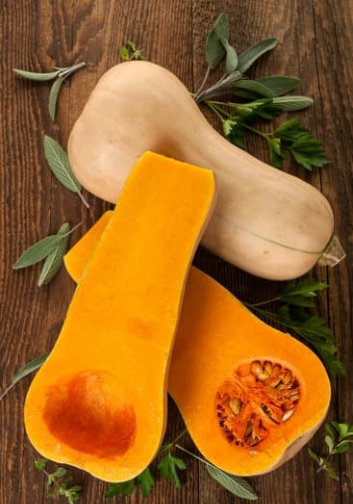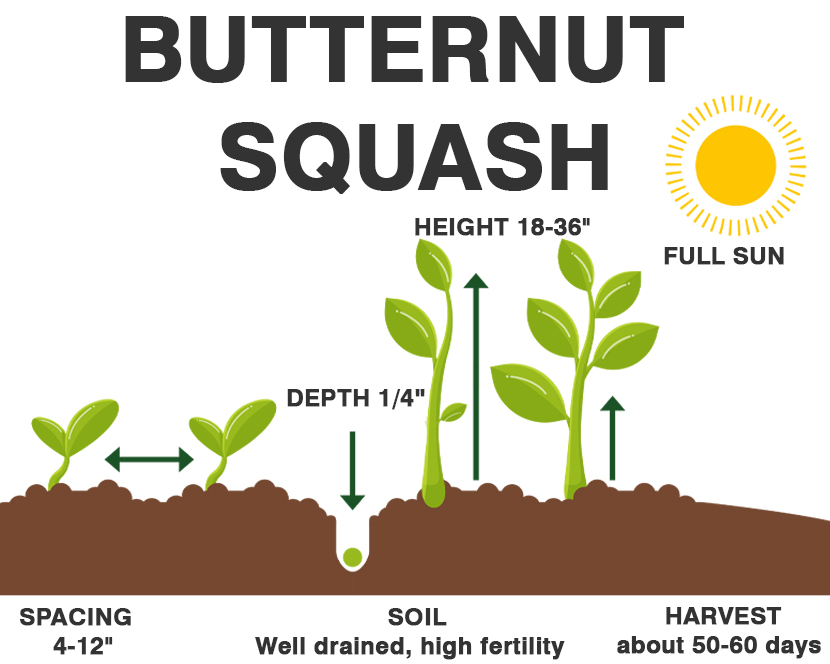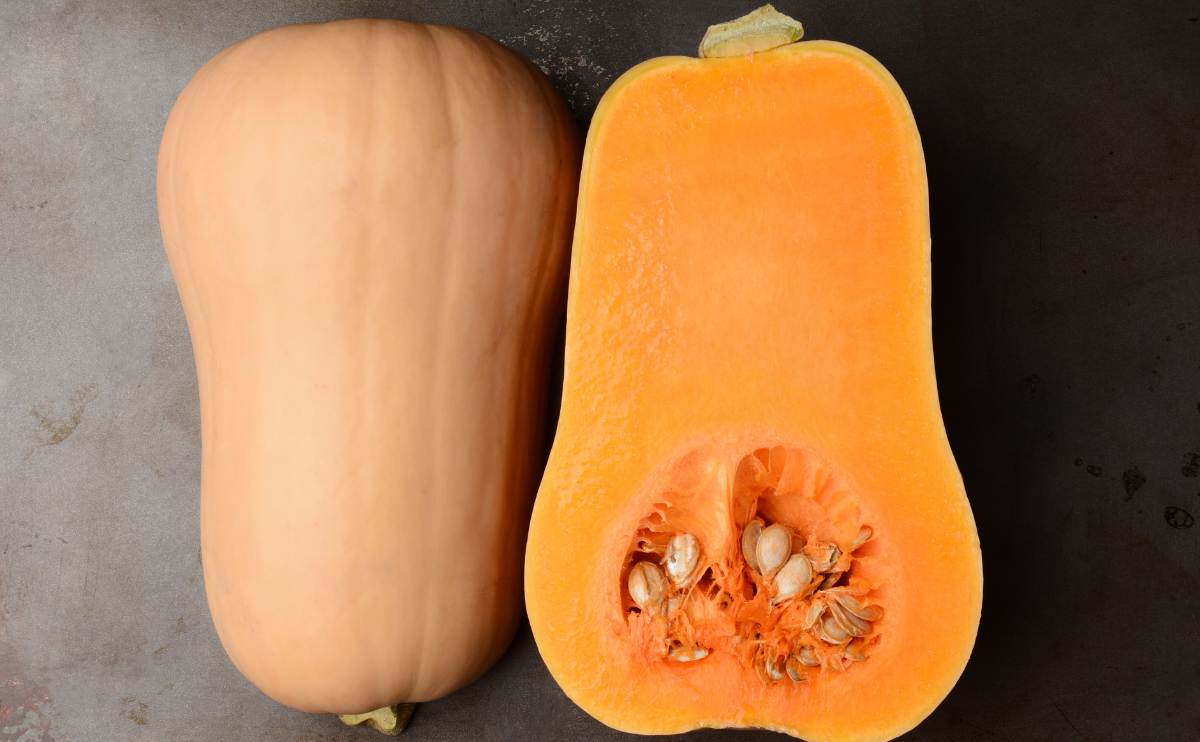Butternut squash (Cucurbita moschata) is a type of winter squash. The fruit starts out with a light green skin, but its skin, or shell, turns beige when the squash is ready to be harvested in fall. The flesh is dense and rich-orange in color. Some people roast butternut squash and use it in soups, while others boil it, mash it, and serve it in place of mashed potatoes. This nutritious vegetable (technically a fruit) is high in vitamin A.
Butternut squash plants are annuals that grow in almost any climate. They are planted in spring, following the last frost of the season. Their vines grow quickly, but the fruits may not be ready to harvest for three to four months from planting time. For smaller space gardens, bush varieties of butternut squash are also available.

| Botanical Name | Cucurbita moschata |
| Common Names | Butternut squash, Butternut pumpkin, Gramma |
| Plant Type | Annual |
| Mature Size | 9-18 in. tall, 10-15 ft. wide (vine length); bush varieties take up less space |
| Sun Exposure | Full sun |
| Soil Type | Rich, well-drained |
| Soil pH | Acidic to neutral (5.5 to 7.0) |
| Bloom Time | Summer |
| Flower Color | Yellow |
| Hardiness Zones | 2 to 11 (UDSA) |
| Native Area | Central America, South America |

When to Plant?
This will be determined by your planting zone. There is a final frost date for each area. As a result, you can plan your gardening activities around this date. Check our Frost Dates Across North America: First & Last Frost Dates Chart. However, the date will not be the same for every plant.
How to Plant
Both summer and winter squash are warm weather plants. Wait until the soil temperature has warmed to at least 60 °F before direct seeding to ensure your seeds don’t rot before they sprout. You can also sow your squash seeds inside or in a heated greenhouse 2 to 4 weeks before the last frost date. The same goes for transplants: don’t set out until the weather has warmed to 70 °F

In general, squash plants like lots of room to spread out. Seeding squash directly into the ground starts with choosing your favorite seed, soaking the seed overnight (optional), and planting 3-6 seeds in a cluster. Once the seeds have sprouted, choose the strongest and remove the rest. When your plants have their first set of true leaves, mulch the soil to retain moisture. Keep the mulch back from plants a few inches to discourage stem rot.
If you don’t have enough time to start squash from seed, buying a few starter plants from your local nursery or farmer’s market is a good way to get a jump on the season. This works particularly well in colder climates where the growing season is short. Most plants will recover from the shock of being moved. Just remember to minimize disturbance to the plants’ roots.
How to Cultivate
Squash like a slightly acidic soil: between 6.0 to 6.8 pH is best. Squash can tolerate a soil pH as low as 5.5, so don’t worry about liming unless your soil is strongly acidic. Always perform a soil test before adding anything that will affect your soil’s pH.
Squash need one inch of water per week. To put that into perspective, you’ll need to water mature squash plants once a week, so the soil is moist 8 to 12 inches beneath the surface. If your soil is very sandy or the weather is smoking hot, you’ll need to water more frequently.
Drip spikes attached to a drip irrigation system are an excellent way to ensure your squash plants get adequate water. Another method involves burying a perforated tin can beside your seedling at planting time, and filling this can daily to a few times per week. Using this method, you’re sure to get water to your plants’ roots.
Squash plants require full sun to produce. Make sure you’re planting your seeds or starts in an area with at least 6 hours of sunlight per day. (You can use a sunlight calculator to find out.) More is better, but if the weather gets too hot for too long, your squash plants may droop with stress. If this happens, it’s a sign your plant is trying to conserve its resources. Most will perk up again when the heat subsides in the evening, but if they don’t, consider adding a shade cloth or other temporary heat protection.
How to Harvest
Summer – 60-70 days. These squash are picked immature before they are fully formed. The skin should be soft and tender, otherwise the squash will be overripe and of poor quality.
Check squash plants almost daily when they start to flower, as the fruit will develop in 2 or 3 days in hot growing weather. The vines must be kept picked or the plants will stop producing.
Winter – 90-120 days. When the stems turn a light green yellow color, the squash should be fully ripe. The rind will be thick and tough. Cut, do not pull, the ripe fruit from the plant. Two to three inches of stem must remain for proper storing. This may increase the sugar content.
Hydroponics
Germination: Start by soaking Butternut squash seeds in water for 24 hours to improve germination rates. Place the seeds in a growing medium, such as rockwool cubes, and keep them moist until they germinate. Once the seedlings have emerged, transfer them to the hydroponic system.
pH range: Butternut squash prefers a slightly acidic to neutral pH range of 5.5-7.0. Test the pH level of the nutrient solution regularly and adjust it accordingly using pH up or pH down solutions.
EC: The electrical conductivity (EC) of the nutrient solution should be between 2.0-2.5 mS/cm for Butternut squash. Monitor the EC level regularly using a digital meter and adjust it by adding or reducing nutrient solution.
PPM: The recommended parts per million (PPM) range for Butternut squash is between 1000-1400 ppm. Check the PPM level of the nutrient solution frequently and adjust it by adding or reducing nutrients as needed.
Humidity: Butternut squash requires moderate to high humidity levels between 60-70%. Maintain proper humidity levels by using a humidifier or misting system if necessary.
Light hours: Butternut squash requires at least 12-14 hours of light per day to grow properly. Use full-spectrum LED grow lights that mimic natural sunlight for optimal growth.
Temperature air: Butternut squash prefers warm air temperatures between 70-80°F (21-27°C) during the day and slightly cooler temperatures between 60-70°F (15-21°C) at night. Monitor the temperature using a thermometer and maintain it by using a heater or air conditioning system as needed.
Temperature water: The ideal water temperature for Butternut squash is between 65-75°F (18-24°C). Use a water chiller or heater to regulate the water temperature and ensure it remains within the appropriate range.
By following these guidelines, you should be able to successfully grow Butternut squash hydroponically. Good luck!



